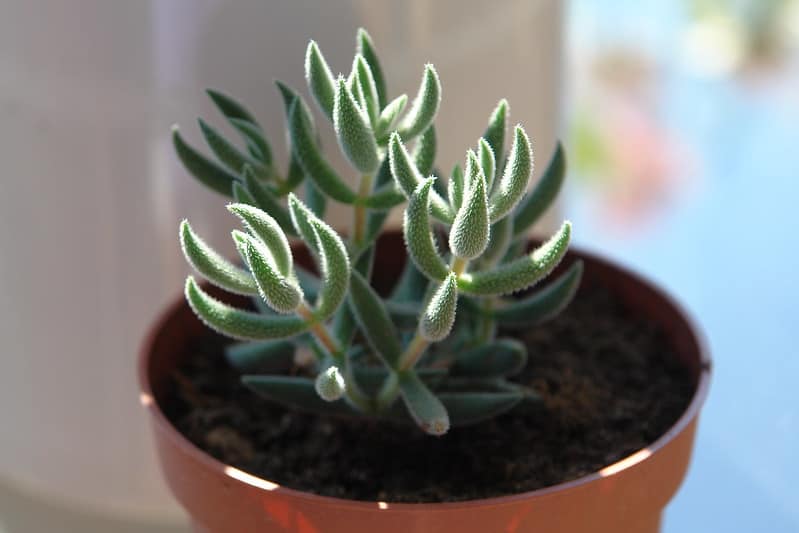Crassula Mesembryanthemoides is a small succulent herbaceous plant belonging to the Crassulaceae family and native to the southern African continent.
It grows mainly in the low areas of shrubs or small trees that allow the filtration of sunlight.
It is confused on numerous occasions with a species of the Aizoaceae family because of the morphological similarity that this plant presents with some of the family mentioned above.
Besides, it is a highly sought-after plant as a kind of collection for its simple care and great beauty.
The stems are thin, erect and very branched with the surface covered by numerous whitish filaments of small size.
This species fails to exceed 15 cm in height if it receives the necessary luminosity.
On the stems, opposite leaves are arranged more or less tight (rosettes are observed towards the ends of the stems), fleshy, with the sharp apex and very elongated.
These leaves tend to bend slightly upwards.
Also, they are covered by numerous whitish filaments and exhibit a light green coloration.
The flowers are small and are arranged in small inflorescences that arise in the apical regions of the stems.
The corolla segments have a short bell shape and show a pinkish color.
The flowering time of the Crassula mesembryanthemoides is from late summer to autumn.
Tips to take care of the Crassula mesembryanthemoides
Undoubtedly, this plant is ideal for succulent collectors as for beginners, since it is an easy plant to care for.
This is a plant that requires minimal care and is beautiful. So you will have a beautiful and different plant and with minimum care.
So if you are one of the people who die easily or do not have much time to devote to your plants, I recommend this succulent.
Illumination
This plant must be grown in a very well lit area to avoid the etiolation of the stems.
Cultivation under sunlight filtered by shading meshes is advised as the intense sun can cause burns.
Or you can choose to put this plant under a larger tree to protect the plant from direct sun.
Temperatures
It grows best under the influence of cool or warm temperatures.
The optimum range for this species is between 18ºC to 26ºC.
Does not tolerate elongated exposure at temperatures below 5ºC.
Substratum
The substrate you use must have rapid drainage of water and very good aeration.
This plant grows well on commercial substrates for succulent plants with an extra aggregate of coarse sand or other material that improves drainage.
If you use a compact substrate, it will cause the roots of the plant to rot easily, because this type of sustain has to pool, which does not please succulents.
Irrigation Frequency
Water preferably when the surface of the substrate is completely dry.
It is recommended to water by immersion to prevent water droplets from accumulating between the filaments of stems and leaves (they promote the appearance of pathogenic fungi).
In winter, irrigation should only be carried out if temperatures exceed 14ºC.
Plagues and diseases
Crassula mesembryanthemoides is very frequently affected by mealybugs and aphids that are housed in leaf stems and bases.
If your plant is attacked by any of these pests, it is important to control them quickly, as they promote the proliferation of pathogenic fungi.
It can also be attacked by mollusks (snails and slugs) that devour stems and leaves. Some wild birds like Passer domesticus can peck the foliage.
Multiplication
Simple from cuttings of stems about 8 cm long.
Cuttings tend to root easily in this species.
You just have to carefully remove one of the cuttings from the mother plant. Then, let the cutting stand for 24 hours.
Prepare a pot with a substrate and put the scheme on top of the substrate.
Keep the substrate slightly moist and semi-shade.
Avoid watering the cutting directly, as it could rot. It will be a matter of waiting for the cutting to begin to take root.
